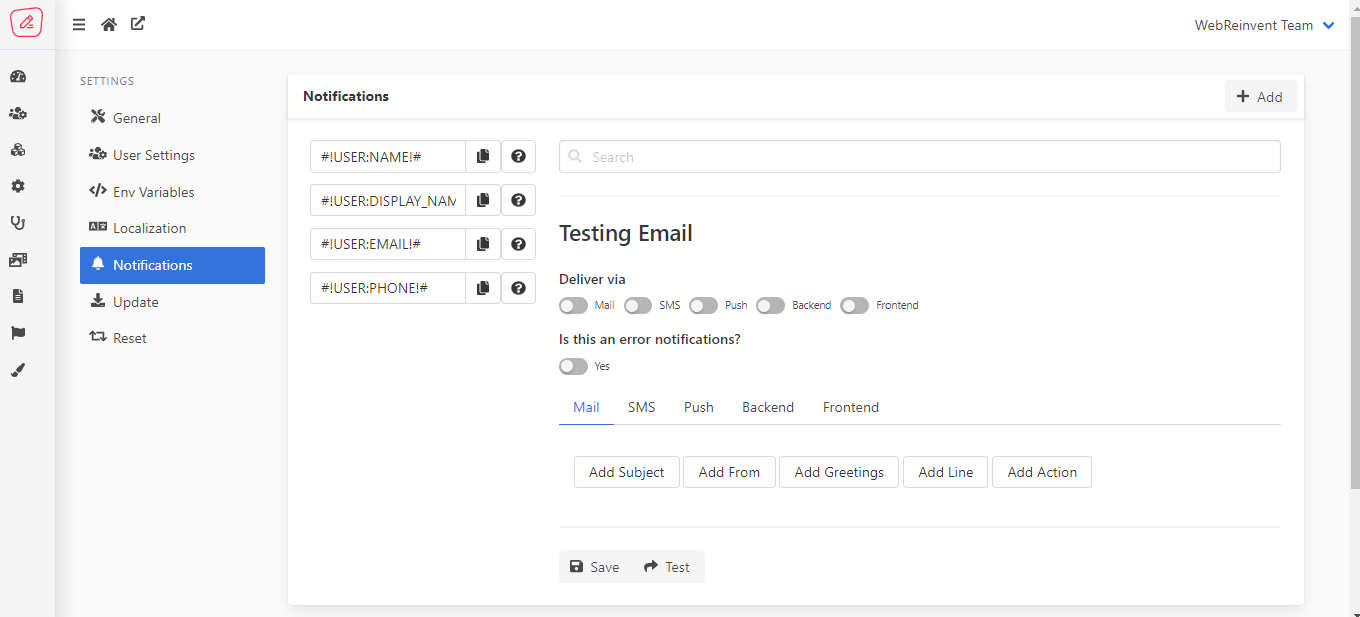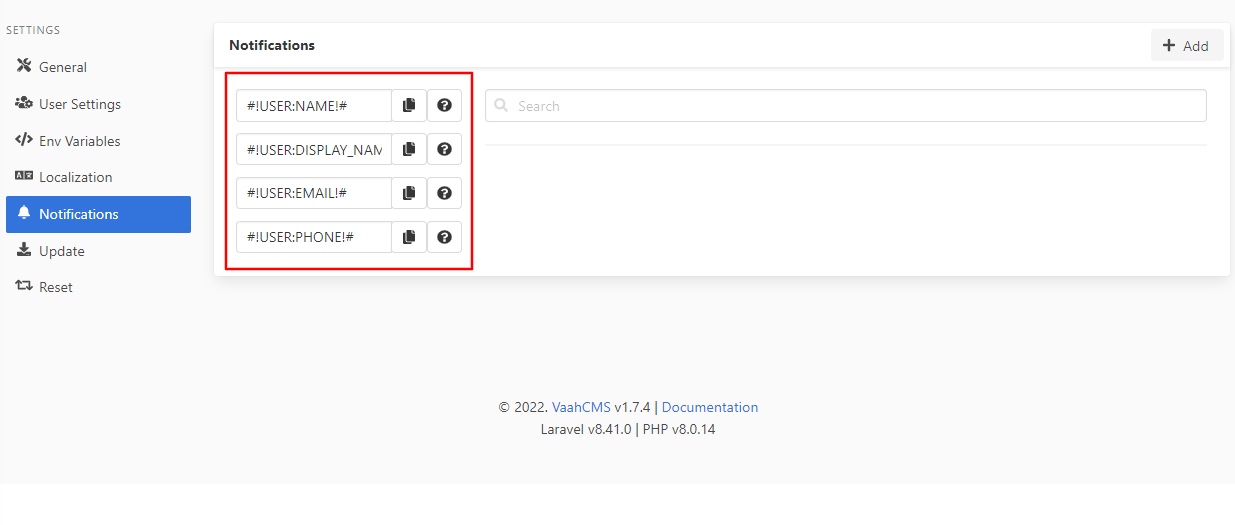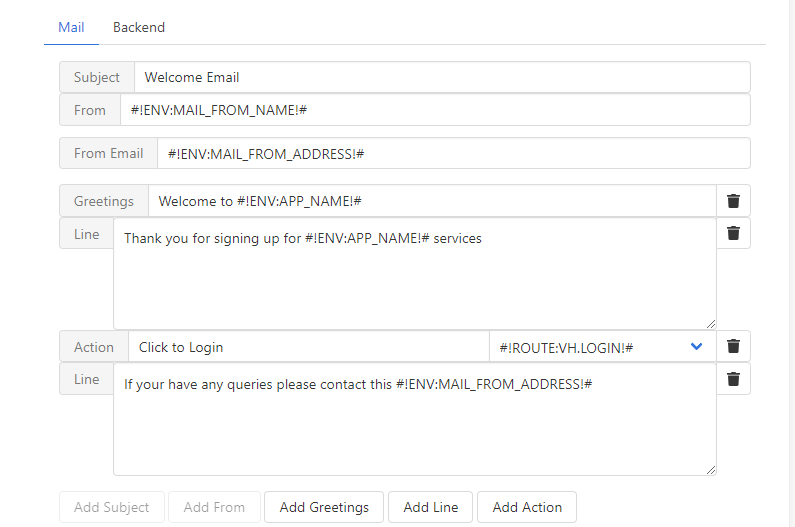Notifications
YOU'RE READING AN OUTDATED DOCUMENTATION.
Latest documentation of
VaahCMS 2.x is available at: Setup Laravel Queues for VaahCMS
Follow the following steps:
- Set
QUEUE_CONNECTIONtodatabasein your activeenvfile - Visit
Setting > General > Site Settings > Laravel Queuesin yourbackend dashboardand enable it. - Run or setup
cron/daemonjob forphp artisan queue:work --queue=high,medium,low,default --env=env_filename
If you want to run without cache use following command:php artisan queue:listen --queue=high,medium,low,default --env=env_filenameeg:php artisan queue:listen --queue=high,medium,low,default --env=develop
If you make any changes in code of your Job class, then you must restart the queue:work command.
Note: When sending notifications, be sure to set the MAIL_FROM_ADDRESS and MAIL_FROM_NAME in your env file. This value will be used as the sender of the email and name of your mail notification messages.
How to create new notification?
There are two way to create notifications:
- Using
Backend > Settings > Notifications - Use
Seeds
1. Create notification from Backend
Login to Backend Administrator Control Panel (<public-url/backend), then navigate to Settings > Notifications.

Here you will be able create new notifications which can be used in your code.

2. Create notification via Seeds
You need to create two json files in your module or theme at following locations:
<theme-or-module-path>/Database/Seeders/json/notifications.json with following content:
[
{
"name": "<notification-name>",
"via_mail": 1,
"via_sms": 0,
"via_push": 0,
"via_backend": 1,
"via_frontend": 0
}
]
You can choose the various via by which you want to send the notification.
<theme-or-module-path>/Database/Seeders/json/notification_contents.json
In this file slug is coming from the <notification-name> and each {} object represent the a line for the notification.
[
{
"slug": "<notification-name-slug>",
"via": "mail",
"sort": 0,
"key": "subject",
"value": "Welcome Email"
},
{
"slug": "<notification-name-slug>",
"via": "mail",
"sort": 1,
"key": "from",
"meta": {
"name": "#!ENV:MAIL_FROM_NAME!#"
},
"value": "#!ENV:MAIL_FROM_ADDRESS!#"
},
{
"slug": "<notification-name-slug>",
"via": "mail",
"sort": 2,
"key": "line",
"value": "Hello #!USER:NAME!#"
},
{
"slug": "<notification-name-slug>",
"via": "backend",
"sort": 0,
"key": "content",
"value": "Lorem ipsum #!ENV:APP_NAME!#. Thanks!"
},
{
"slug": "<notification-name-slug>",
"via": "backend",
"sort": 1,
"key": "action",
"value": "Click",
"meta": {
"action":"#!ROUTE:VH.VERIFICATION!#"
}
}
]
| Name | Description |
|---|---|
slug | It is the slug of the notification name. |
via | Represent that this {} object belong to how the notification will be sent. |
sort | Index or sequence of the each object. |
key | This represent the type of object. mail can have following keys : greeting, line, action, from, subjectbackend can have following keys: content, action |
value | Value contain the actual content of the key. This can have dynamic values like #!ENV:APP_NAME!# will be replace by the APP_NAME |
| meta | Any additional information required. Eg: For key action it requires Label and Link like a hyperlink requires a Label and Link |
Now to these notification should be created, whenever the module or theme gets activated. So, now we need to use DatabaseTableSeeder.php , add following methods to seed these notifications:
...
public function run()
{
$this->seedNotifications();
$this->seedNotificationContent();
}
public function seedNotifications()
{
$list = \VaahSeeder::getListFromJson(__DIR__."/json/notifications.json");
\VaahSeeder::storeSeedsWithUuid('vh_notifications', $list);
}
public function seedNotificationContent()
{
$list = \VaahSeeder::getListFromJson(__DIR__."notification_contents.json");
foreach($list as $item)
{
$notification = \DB::table( 'vh_notifications' )
->where( 'slug', $item['slug'] )
->first();
$exist = \DB::table( 'vh_notification_contents' )
->where( 'vh_notification_id', $notification->id )
->where('sort', $item['sort'])
->where('via', $item['via'])
->first();
$item['vh_notification_id'] = $notification->id;
if(isset($item['meta'])){
$item['meta'] = json_encode($item['meta']);
}
unset($item['slug']);
if(!$exist)
{
DB::table('vh_notification_contents')->insert($item);
} else{
DB::table('vh_notification_contents')
->where( 'vh_notification_id', $notification->id )
->where('sort', $item['sort'])
->where('via', $item['via'])
->update($item);
}
}
}
...
How to show notification variables?
If you want to show variables name in notification sidebar.

You need to add getNotificationVariables method in ExtendController of your Theme or Module.
public function getNotificationVariables()
{
$list = [
[
'name'=>'#!USER:NAME!#',
'details'=>'Will be replaced with name.',
],
[
'name'=>'#!USER:DISPLAY_NAME!#',
'details'=>'Will be replaced with display name.',
],
[
'name'=>'#!USER:EMAIL!#',
'details'=>'Will be replaced with email.',
],
[
'name'=>'#!USER:PHONE!#',
'details'=>'Will be replaced with phone.',
]
];
$response['status'] = 'success';
$response['data'] = $list;
return $response;
}
How to add notification actions?
If you want to add action variables in notification.

You need to add getNotificationActions method in ExtendController of your Theme or Module.
public function getNotificationActions()
{
$list = [
[
'name'=>'#!ROUTE:VH.LOGIN!#'
],
[
'name'=>'#!ROUTE:VH.REGISTER!#'
],
[
'name'=>'#!ROUTE:VH.RESET!#'
],
[
'name'=>'#!ROUTE:VH.VERIFICATION!#'
]
];
$response['status'] = 'success';
$response['data'] = $list;
return $response;
}
How to use variable strings?
There are three types of variable strings.
#!USER:VARIABLE_NAME!#: If the notification contains #!USER:NAME!# string and then the $input array must be: $inputs = "user_id" => X. This will replace the string with value provided in the User Entity.#!PARAM:VARIABLE_NAME!#: If the notification contains #!PARAM:NAME!# string and then the $input array must be: $inputs = "name" => "John". This will replace the string with value provided in the inputs.#!ROUTE:VARIABLE_NAME!#: If the notification contains #!ROUTE:VH.LOGIN!# string. This will replace the string withurlof thatroute nameprovided in thePHP Routes.
$notification = WebReinvent\VaahCms\Entities\Notification::where('slug', "<notification-slug>")->first();
if($notification)
{
$inputs = [
"user_id" => xxx,
"notification_id" => xxx,
];
WebReinvent\VaahCms\Entities\Notification::send(
$notification, $user, $inputs
);
}
How to add Custom Url?
To add custom url, you need to add param string of custom url: #!PARAM:CUSTOM_URL!#.
You can add this param string in Notification Actions.
public function getNotificationActions()
{
$list = [
[
'name'=>'#!PARAM:CUSTOM_URL!#'
]
];
$response['status'] = 'success';
$response['data'] = $list;
return $response;
}
This is how you can add custom url in method.
$notification = WebReinvent\VaahCms\Entities\Notification::where('slug', "<notification-slug>")->first();
if($notification)
{
$inputs = [
"user_id" => xxx,
"notification_id" => xxx,
"custom_url" => 'https://custom-url',
];
WebReinvent\VaahCms\Entities\Notification::send(
$notification, $user, $inputs
);
}
Sending without Laravel Queues
If you want to send the notification without Laravel queues, you can use following code
$notification = WebReinvent\VaahCms\Entities\Notification::where('slug', "<notification-slug>")->first();
if($notification)
{
$inputs = [
"user_id" => xxx,
"notification_id" => xxx,
];
WebReinvent\VaahCms\Entities\Notification::send(
$notification, $user, $inputs
);
}
Sending notifications with Laravel Queues
Note: By default VaahCMS does not use Laravel queues/jobs to send the notification. You must enable it, read Setup Notifications with queues section to know more
To send notification with Laravel Queues, you can use following code:
$notification = WebReinvent\VaahCms\Entities\Notification::where('slug', "<notification-slug>")->first();
if($notification)
{
$inputs = [
"user_id" => xxx,
"notification_id" => xxx,
];
WebReinvent\VaahCms\Entities\Notification::dispatch(
$notification, $user, $inputs, $priority
);
}
| Name | Description |
|---|---|
$notification | is the instance of WebReinvent\VaahCms\Entities\Notification |
$user | is the instance of WebReinvent\VaahCms\Entities\User |
$inputs | is the a data array contain values of strings. user_id and notification_id are required params. Eg. 1. If the notification contains #!PARAM:NAME!# string and then the $input array must be: $inputs = "name" => "John" This will replace the string with value provided in the inputs. 2. If the notification contains #!USER:NAME!# string and then the $input array must be: $inputs = "user_id" => X This will replace the string with value provided in the User Entity. |
$priority | it is the order of execution of the jobs. You can provide following values: high ,medium, low, & default |
Example
In this example, we register a greeting, a line of text, a call to action, and then another line of text.

Notification Seeds
notifications.json
[
{
"name": "Send Welcome Email",
"via_mail": 1,
"via_sms": 0,
"via_push": 0,
"via_backend": 1,
"via_frontend": 0
}
]
notification_contents.json
[
{
"slug": "send-welcome-email",
"via": "mail",
"sort": 0,
"key": "subject",
"value": "Welcome Email"
},
{
"slug": "send-welcome-email",
"via": "mail",
"sort": 1,
"key": "from",
"meta": {
"name": "#!ENV:MAIL_FROM_NAME!#"
},
"value": "#!ENV:MAIL_FROM_ADDRESS!#"
},
{
"slug": "send-welcome-email",
"via": "mail",
"sort": 2,
"key": "line",
"value": "Hello #!USER:NAME!#"
},
{
"slug": "send-welcome-email",
"via": "mail",
"sort": 3,
"key": "greetings",
"value": "Welcome to #!ENV:APP_NAME!#"
},
{
"slug": "send-welcome-email",
"via": "mail",
"sort": 4,
"key": "line",
"value": "Thank you for signing up for #!ENV:APP_NAME!# services"
},
{
"slug": "send-welcome-email",
"via": "mail",
"sort": 5,
"key": "action",
"value": "Click to Login",
"meta": {
"action":"#!ROUTE:VH.LOGIN!#"
}
},
{
"slug": "send-welcome-email",
"via": "mail",
"sort": 6,
"key": "line",
"value": "If your have any queries please contact this #!ENV:MAIL_FROM_ADDRESS!#"
}
]
Use following code to send a Notification.
$notification = WebReinvent\VaahCms\Entities\Notification::where('slug', "send-welcome-email")->first();
if($notification)
{
$inputs = [
"user_id" => xxx,
"notification_id" => xxx,
];
WebReinvent\VaahCms\Entities\Notification::send(
$notification, $user, $inputs
);
}
The notification channel will then translate the message components into a beautiful, responsive HTML email template with a plain-text counterpart. Here is an example of an email generated by the notification:

Note: When sending notifications, be sure to set the APP_NAME in your env file. This value will be used in the header and footer of your mail notification messages.